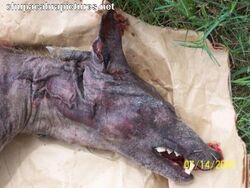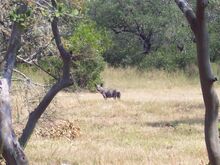No edit summary |
No edit summary |
||
| Line 6: | Line 6: | ||
According to some scientists, it could be a deformed coyote, but this does not explain their tendency to suck all the blood from their victims neck. |
According to some scientists, it could be a deformed coyote, but this does not explain their tendency to suck all the blood from their victims neck. |
||
| − | |||
| − | my uncle had seen the creature.i have also. it bit me. bit me. BIT ME! my uncle had seen it lurking and sent his dogs after it. the dogs were found with three puncure marks in there necks. |
||
| − | |||
| − | i was hiking and shot at it, but it didnt fall.instead it ran up to me ana bit my fingure. |
||
<gallery widths="220"> |
<gallery widths="220"> |
||
Revision as of 18:56, 6 January 2013
A beast that is known widely known for its attack on livestock. It is found in the Texas-Mexico area. It is famous for its attacks on goats, hence its name which means "goatsucker". There are two common sightings of the Chupacabra. There is the reptilian kind, and the canine kind. There have been more than 2,000 sightings of the Chupacabra. The canine version of some Chupacabras resemble a Xolo, a hairless dog native to Mexico. The so-called "Texas Chupacabra" appears to a canid, possibly a mangey Coyote. Although it is known from Texas and Mexico, it has been sighted as far north as southern Ohio. When it sucks blood, it alegedly makes a sound (See link).
Evolution

What may be the only picture of a "Chupacabra" in action
15 mya - In the Miocene, many new groups of creatures evolve; in Mexico and the islands of the Gulf of Mexico, a new group of Therocephalians known as the Chupacabrians evolve, and in Africa, sauropods which is the Titinosaurus evolve into the Mokele-Mbembe and Tyrannosaurs which is the Tyrannosaurus Rex evolve into the Kasai Rex. Also, in the oceans, a group of mosasaurs evolves into Sea Serpents. Therocephalians were prehistoric reptilian mammals, evolutionary crosses between reptiles and mammals, that inhabited the earth during the Permian to the Early Triassic. Therocephalian during the Triassic looked very similar to mammals, some looking like wolves without fur and scales skin. Despite this, these animals that would evolve into mammals later, had still retained reptilian features, such as a lack of hair, and even poison glands and spine spikes. Therocephalians' closest known modern day relative are the Platypus, which lay eggs and have a poison gland, like a Therocephalian. Chupacabras resemble the dog-like structure of the Therocephalian, and have been described as "Reptilian Dogs." They look either more like mammals or more reptilian depending on the species.
According to some scientists, it could be a deformed coyote, but this does not explain their tendency to suck all the blood from their victims neck.



